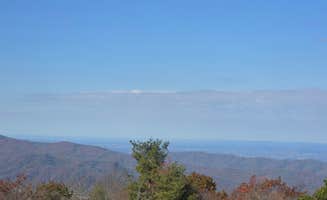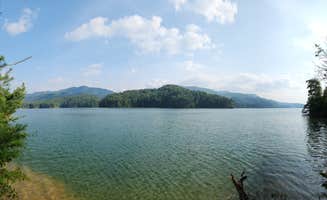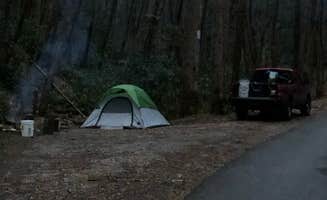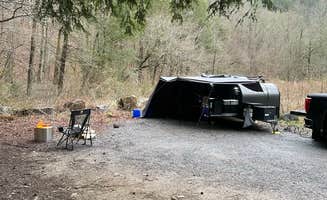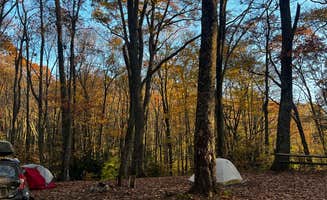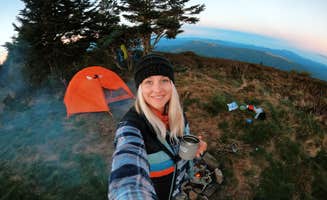Dispersed camping near Church Hill, Tennessee extends beyond the Cherokee National Forest to include primitive sites in Virginia and North Carolina. Most locations sit at elevations between 1,800 and 6,000 feet, with summer temperatures typically 5-10 degrees cooler than in town. Winter camping remains accessible at lower elevations, while mountain sites often close seasonally due to ice and snow accumulation on forest roads.
What to do
Fishing access points: Several dispersed camping areas provide direct water access. At Hidden Valley WMA, campers can fish the lake from shore. "Easy to access in a vehicle several campers campsites available. Lake is calm and clean for water recreation," notes Kathleen B.
Hiking from camp: The Paint Creek Corridor offers trail access directly from camp. "The national forest service website says there are dispersed camping site throughout the corridor; however, I was only able to locate one and luckily it was vacant," explains Andrew S., highlighting the limited availability despite good trail connections.
Photography viewpoints: Mountain overlooks provide exceptional sunset and sunrise photography opportunities. Tripp T. describes Unaka Mountain Overlook: "2 Stars but just for the view... The sunset was amazing but unfortunately the areas around the established fire rings had trash and a lot broken glass scattered about."
What campers like
Established amenities: Some primitive sites offer basic facilities. At Hidden Valley WMA, Betsy W. mentions, "Porta Jon available at campground and boat dock. Plenty of dead wood for fires. Trash cans available. Rocks for fire pits and no tables."
360-degree vistas: High-elevation camping provides panoramic views. At Grassy Ridge Bald - Dispersed BackCountry, Andrew notes: "Beautiful 6000' bald off the AT and along the state line between North Carolina and Tennessee, plenty of places to pitch a tent. Firewood is scarce so bring a lantern and cook stove."
Water proximity: Some sites allow camping near streams or lakes. Brendan G. describes Little Stony Creek Road Dispersed Area: "Stayed a night out here while traveling, scary narrow rocky trails, but beautiful streams and mountains."
What you should know
Permit requirements: Many sites require permits. Hidden Valley WMA requires a Virginia Wildlife Access pass ($4) with camping authorization for stays up to 14 days. Rhys R. confirms: "Camping is free, technically. (you need to purchase an Access pass from Virginia Wildlife for 4 dollars online, and add a camping authorisation to your account)."
Road conditions: Access to mountain sites can be challenging. Zoey T. warns about Hidden Valley WMA: "The road up is a pretty harsh grade for 4 miles. Our short bus Skoolie had some troubles with it."
Site cleanliness concerns: Unfortunately, trash issues affect some areas. Regarding Paint Creek Corridor, Andrew S. observed "a lot of trash in the area of the site sadly."
Tips for camping with families
Prepare for wind exposure: Mountain balds have limited natural windbreaks. Kelly G. from Grassy Ridge Bald - Dispersed BackCountry advises: "This was truly one of my most memorable campsites I've ever stayed at... There was an evening thunderstorm over an adjacent mountain, a beautiful sunset, a full moon to howl at, and a sunrise that can't be beat."
Pack essential gear: No amenities means bringing everything. Carissa D. notes about Grassy Ridge Bald: "There are not too many spots to gather firewood. A few sites already have rock pits made for you. Super windy so dress appropriately!"
Consider noise levels: Some free sites experience significant road noise. Sophia L. warns about Little Stony Creek: "Pros: Free, many sites with water access for kayaking/fishing, fire rings, parking lot close to sites. Cons: Lots of road noise... Trash everywhere making some sites unusable. Lots of poison ivy."
Tips from RVers
Size restrictions: Most dispersed sites accommodate small vehicles only. At Hidden Valley WMA, Rhys R. noted: "This spot is very nice, close to the water's edge (although no camping allowed lakeside). There's quite a few rings, bear bins, and a porta-loo. We had the place to ourselves which was really great."
Bring portable waste systems: No dump stations exist at dispersed sites. While primitive sites lack facilities, bringing portable systems allows for longer stays.
Scout ahead if possible: Due to limited site availability and poor signage, scouting first is recommended. Andrew S. shared his experience at Paint Creek Corridor: "I had to drive almost 4 hours to get there and would have been super disappointed if I arrived to no spots."



